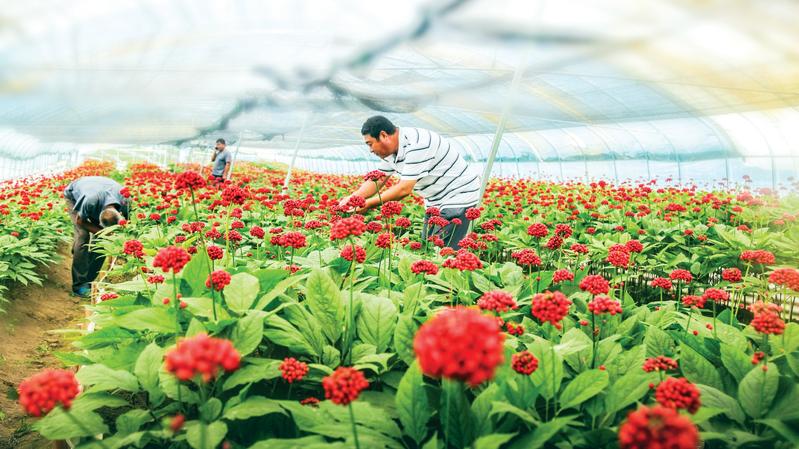 Workers inspect ginseng plants in bloom at a greenhouse in Fusong. (PHOTO PROVIDED TO CHINA DAILY)
Workers inspect ginseng plants in bloom at a greenhouse in Fusong. (PHOTO PROVIDED TO CHINA DAILY)
Cui Chang’an, 65, a native of Fusong county, Jilin province, has been looking for and digging up ginseng for almost 50 years.
Although it is difficult to find good-shaped, large wild ginseng that has grown for a long time in the forest and mountainous areas, Cui said the skills needed to locate and pick the precious herb must not be lost.
Fusong, which is at the northwestern foot of Changbai Mountain, is known as the “hometown of ginseng”, because the area is home to numerous forests, boasts rich and fertile soil, and has humid and cool weather — ideal conditions for the plants to grow.
The slow-growing herb has a light-colored, fleshy root, a relatively long stem, green, oval-shaped leaves and red fruits.
Legends and myths about the ginseng root abound among the older generation since it resembles an energetic man. For example, many experienced pickers tie a red cord around the stem of wild ginseng after finding the herb in forests as, according to a saying, “Ginseng will run away like a man if it is not tied down.”
The herb is believed to restore and enhance well-being by boosting energy levels, lowering blood sugar and cholesterol, reducing stress and assisting relaxation.
This year, it has been used in many traditional Chinese medicines that have been effective in preventing COVID-19 and relieving symptoms of the disease.
In the 1980s, wild ginseng was listed as an endangered plant, hence no private individuals could dig it up. According to national forestry regulations, personnel from government departments and private individuals cannot pick the wild plants or destroy their growing conditions in ecologically protected areas.
As a result, ginseng that has grown for more than 100 years is seldom picked in Fusong. Most ginseng growing in the wild is now the result of seeds being spread by humans. Compared with purely wild ginseng, it is cheaper and has a shorter growing period. However, both types have similar health benefits.
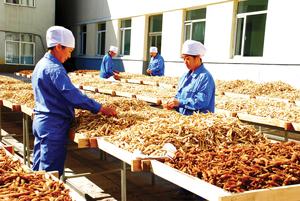 Workers dry and select ginseng in Fusong. (PHOTO PROVIDED TO CHINA DAILY)
Workers dry and select ginseng in Fusong. (PHOTO PROVIDED TO CHINA DAILY)
In addition, cultivated ginseng has proved popular in Fusong in recent decades. Although this variety is cheaper and its efficacy does not match that of wild ginseng, it can meet market demand and has a much shorter growing time.
In June, the value of ginseng-related industries in Jilin was about 52.7 billion yuan (US$6.85 billion) in 2019, according to the Provincial Department of Agriculture and Rural Affairs. The number of industries related to the herb, including food, medicine and cosmetics, was rising, the department said.
GDP in Wanliang, a ginseng township in Fusong, reached 1.02 billion yuan last year and farmers were each earning more than 16,000 yuan annually, according to a statement issued by the county government.
It also said efforts have been made to help local residents use e-commerce platforms, livestreaming and artificial intelligence to sell ginseng.
Accompanied by his father and grandfather, Cui, the Fusong native, trekked through mountains and forests to seek wild ginseng when he was just 7 or 8 years old. When he was 18, he led a team that searched for the herb.
The history of picking ginseng can be traced to the end of the Qing Dynasty (1644-1911) when many people left their hometowns for northeastern areas of China, where they made a living from it.
Cui said being a team leader requires keen eyesight, confidence and the ability to ensure the safety of every picker and prevent the team from getting lost in mountainous terrain. A degree of luck is also useful.
He added: “It’s hard to say how long it can take to discover wild ginseng. Usually, we bring some food with us to live in the mountains for a couple of days. Sometimes, we come across wild ginseng just a few minutes after we arrive in the mountains, but on other occasions, it can take more than 10 days to find it.”
He said experienced pickers can estimate the root size of wild ginseng with a 60 percent degree of accuracy, based on the herb’s leaves on the ground. Large, heavy and longer-growing roots are more valuable than others.
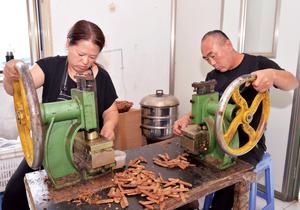 Ginseng is processed by factory workers in Fusong. (ZHAO BO / FOR CHINA DAILY)
Ginseng is processed by factory workers in Fusong. (ZHAO BO / FOR CHINA DAILY)
Delicate process
Experienced pickers follow a set of rules, including only digging up mature roots, leaving others in the ground.
“In other words, the pickers cannot be greedy or blind. We must protect nature to keep it sustainable because it nurtures and provides us with food for generations,” Cui said.
Skill is required to protect ginseng roots as they are being dug up, which can take a picker one to two hours, Cui said. In the case of larger roots, it can take a whole day to extract them.
Xu Guili, 47, often recalls the days when she and her grandfather sought wild ginseng in the mountains, describing this time as “her best memory”.
“Looking for wild ginseng during my childhood meant eating fruit growing wild and having more time to play. I liked the forests and mountains where I could find many interesting plants and beautiful streams,” she said.
Xu described seeking wild ginseng as an “adventure”, adding that it aroused her curiosity and increased her confidence.
She said she discovered her first wild ginseng by accident, adding that it had been a “magical” experience. When she was 10, her grandfather took her into the mountains and tied a rope around her waist to keep her close to him, but after untying the rope, Xu fell down a slope. Wild ginseng was discovered at the spot where she landed.
Like Cui, Xu’s grandfather abided by the rules for picking ginseng, including fastening a red cord around the stem of the plant.
Xu prefers seeking wild ginseng to extracting it “because it took too long to dig up and I often fell asleep”.
After her grandfather died, Xu, then 17, never went to the mountains again. Instead, she has followed her mother in processing and selling wild ginseng.
“Processing is not easy,” she said. For example, the temperature of the water used to wash the herb must be no higher than 25 C, and great care is needed when it is dried. Workers are not allowed to wear hand cream during this process, Xu said.
“We try to keep the original appearance of the ginseng and avoid any loss of nutrients,” she added.
After it is washed and dried, the ginseng is placed on red paperboard. “I enjoy this step the most because I can see different shapes in the plants,” Xu said. “Some resemble cute babies, as the roots are white and fat. Some are like couples, as they embrace each other when being picked.”
In 2012, Xu opened a ginseng museum in Fusong to display different species of the herb and introduce the industry to more visitors. “The museum is like a notebook in which I record my family’s stories about ginseng, which I will pass down to the next generation,” she said.
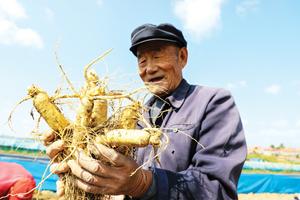 Xu Maojian, 75, has spent his working life growing ginseng in Fusong county, Jilin province. (QI BOZI / FOR CHINA DAILY)
Xu Maojian, 75, has spent his working life growing ginseng in Fusong county, Jilin province. (QI BOZI / FOR CHINA DAILY)
Modern take
The herb matures from July to October. Unlike ginseng in forests, which takes more than 10 years to grow, that which is artificially cultivated in Fusong matures in about four or five years.
This faster growing time has attracted many farmers, including Li Youyi, 64. He began cultivating ginseng in 1983 and said he has raised his family’s standard of living as a result.
Soil fertility caused him a problem. Ginseng absorbs many nutrients as it grows, “so it is difficult to use the land again immediately after the herb matures. We could only start by using new land, or plant some cheap corn,” Li said.
The problem is being addressed by agricultural and technological experts, and some experiments are being developed, Li added.
His 35-year-old son, Li Shouguo, said the family faced another problem in making more customers aware of the business and in securing sales.
“There are challenges in both cultivation and promotion,” Li Shouguo said, adding that he is learning about them from the internet and is also approaching online platforms to sell cultivated ginseng.
He opened an account on the short-video platform Douyin early this year but said few people have followed him and watched his broadcasts. He added he would learn from the experience.
Ma Xiaotong, 30, from Wanliang, Fusong, has had online success with ginseng sales. At the end of 2016, she returned to the county from Shenzhen, Guangdong province, as she wanted to start her own business.
“When I was in Shenzhen, I often worked overtime, but I felt lost in such a big city. I didn’t know why I had to be so busy every day,” she said.
She decided to return home to sell local agricultural produce and herbs on e-commerce platforms.
Although Ma is still working during the day and at night, she no longer feels tired. “I’m now working for myself and know that this is what I must do for my career,” she said.
Ma has opened stores on several major e-commerce platforms, including Taobao and JD, to sell her own brand of ginseng products. In addition to fresh ginseng, she sells related health products such as food, face masks and soap, targeting consumers age 30 to 50.
“These people work overtime and face a burden raising their families, so they have an increased demand for herbal and health products to boost their energy levels and enhance immunity,” she said.
Ma said turnover from her online business from January to August rose fourfold year-on-year.
“This was not only because more people were attaching importance to their health, but was also due to the fact that traditional Chinese medicine was proving effective in relieving COVID-19 symptoms,” she said.
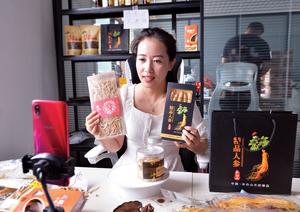 Ma Xiaotong promotes ginseng products on a livestreaming platform. (ZHAO BO / FOR CHINA DAILY)
Ma Xiaotong promotes ginseng products on a livestreaming platform. (ZHAO BO / FOR CHINA DAILY)
Finding prosperity
By assisting local farmers to sell cultivated ginseng online, she has helped more people raise their standard of living.
The Wanliang government has also stepped up efforts to help local farmers cultivate and process the herb and find jobs in related industries, lifting them out of poverty and guiding them toward xiaokang, or moderately prosperous lives.
To date, about 1,000 local residents have used social and e-commerce platforms to sell ginseng, with turnover reaching 200 million yuan.
At the end of last month, Xinhua News Agency reported that more than 2,670 enterprises were processing ginseng in Fusong, with 65 brands and over 500 related products available. Last year, the medical and health industries involved in ginseng contributed about 420 million yuan to the local economy.
As Fusong witnesses industrial prosperity, local families have found their own ways to pass on ginseng-related culture.
Cui has taught his nephew to find and pick wild ginseng, in the hope that the younger generation will not abandon such skills and can continue to abide by the rules to protect the environment.
Xu, who has told her daughter of her own experiences in processing ginseng, has stressed that concentrating on such work is the “biggest form of respect to nature”.
Meanwhile, Li Shouguo and Ma are exploring new ways to promote the herb.
“Showing ginseng to the world and spreading related knowledge to more people is my way of remembering and inheriting the local plant and its culture,” Li said.
Contact the writers at caoyin@chinadaily.com.cn


